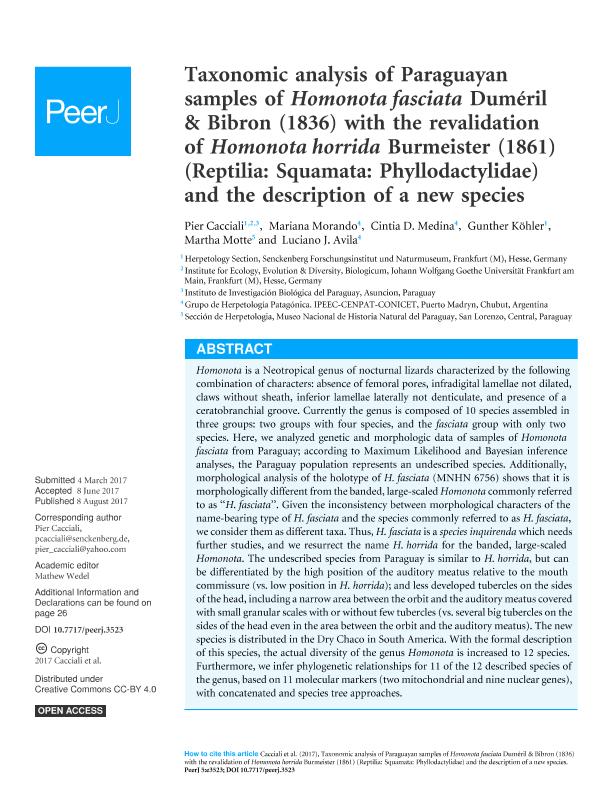Artículo
Taxonomic analysis of Paraguayan samples of Homonota fasciata Duméril & Bibron (1836) with the revalidation of Homonota horrida Burmeister (1861) (Reptilia: Squamata: Phyllodactylidae) and the description of a new species
Cacciali, Pier; Morando, Mariana ; Medina, Cintia Débora
; Medina, Cintia Débora ; Köhler, Gunther; Motte, Martha; Avila, Luciano Javier
; Köhler, Gunther; Motte, Martha; Avila, Luciano Javier
 ; Medina, Cintia Débora
; Medina, Cintia Débora ; Köhler, Gunther; Motte, Martha; Avila, Luciano Javier
; Köhler, Gunther; Motte, Martha; Avila, Luciano Javier
Fecha de publicación:
08/08/2017
Editorial:
PeerJ Inc.
Revista:
PeerJ
ISSN:
2167-8359
Idioma:
Inglés
Tipo de recurso:
Artículo publicado
Clasificación temática:
Resumen
Homonota is a Neotropical genus of nocturnal lizards characterized by the following combination of characters: absence of femoral pores, infradigital lamellae not dilated, claws without sheath, inferior lamellae laterally not denticulate, and presence of a ceratobranchial groove. Currently the genus is composed of 10 species assembled in three groups: two groups with four species, and the fasciata group with only two species. Here, we analyzed genetic and morphologic data of samples of Homonota fasciata from Paraguay; according to Maximum Likelihood and Bayesian inference analyses, the Paraguay population represents an undescribed species. Additionally, morphological analysis of the holotype of H. fasciata (MNHN 6756) shows that it is morphologically different from the banded, large-scaled Homonota commonly referred to as “H. fasciata”. Given the inconsistency between morphological characters of the name-bearing type of H. fasciata and the species commonly referred to as H. fasciata, we consider them as different taxa. Thus, H. fasciata is a species inquirenda which needs further studies, and we resurrect the name H. horrida for the banded, large-scaled Homonota. The undescribed species from Paraguay is similar to H. horrida, but can be differentiated by the high position of the auditory meatus relative to the mouth commissure (vs. low position in H. horrida); and less developed tubercles on the sides of the head, including a narrow area between the orbit and the auditory meatus covered with small granular scales with or without few tubercles (vs. several big tubercles on the sides of the head even in the area between the orbit and the auditory meatus). The new species is distributed in the Dry Chaco in South America. With the formal description of this species, the actual diversity of the genus Homonota is increased to 12 species. Furthermore, we infer phylogenetic relationships for 11 of the 12 described species of the genus, based on 11 molecular markers (two mitochondrial and nine nuclear genes), with concatenated and species tree approaches.
Palabras clave:
Chaco
,
Gekkota
,
Nomenclatural Acts
,
Phylogeny
,
South America
Archivos asociados
Licencia
Identificadores
Colecciones
Articulos(CCT-CENPAT)
Articulos de CTRO.CIENTIFICO TECNOL.CONICET - CENPAT
Articulos de CTRO.CIENTIFICO TECNOL.CONICET - CENPAT
Citación
Cacciali, Pier; Morando, Mariana; Medina, Cintia Débora; Köhler, Gunther; Motte, Martha; et al.; Taxonomic analysis of Paraguayan samples of Homonota fasciata Duméril & Bibron (1836) with the revalidation of Homonota horrida Burmeister (1861) (Reptilia: Squamata: Phyllodactylidae) and the description of a new species; PeerJ Inc.; PeerJ; 2017; 8; 8-8-2017; 1-31
Compartir
Altmétricas



